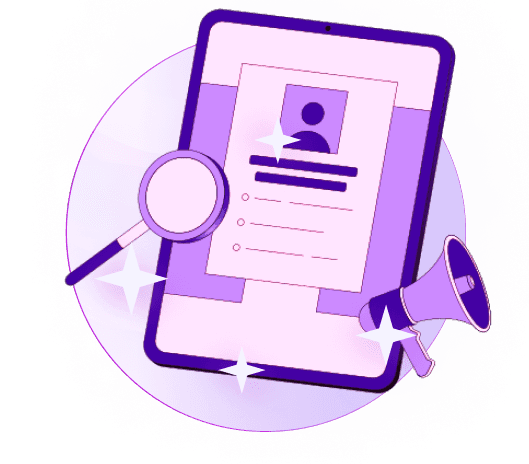Blogs
Articles

How to Build B2B Lead Lists That Actually Convert: A Proven Guide
B2B companies that build their own lead lists achieve up to five times better conversion rates than those buying generic lists. The difference between success and failure comes down to your approach to sourcing and structuring leads.
This piece will teach you how to create B2B lead generation lists that convert. Quality B2B leads should include advanced data points like company structure, tech stack, and annual revenue, unlike simple contact databases.
You'll learn to build a system that delivers results, whether you're looking to get more B2B leads or considering purchased lists. Let's head over to the details!
What is a B2B lead and why it matters?
B2B leads are the life-blood of your sales process. They represent people, organizations, or businesses you might call potential customers for your products or services. These prospects build the foundation of your b2b lead lists and end up determining your conversion success.
Your B2B leads typically fit into two main categories based on their position in your sales funnel. Marketing Qualified Leads (MQLs) show interest in your business through specific marketing activities. These prospects might check out your website multiple times, grab your gated content, fill contact forms, or sign up for webinars. Sales Qualified Leads (SQLs) move further along in their buying experience. They clearly show they want to buy by asking for demos or talking directly to your sales team.
The key difference between MQLs and SQLs matters a lot. MQLs stay in the awareness or interest stage, while SQLs progress to consideration and decision phases. This understanding helps you shape your approach to building effective b2b lead generation lists.
How to Build a B2B Lead List Step-by-Step
Building effective b2b lead lists needs smart methods and the right tools. Here's a step-by-step approach that turns prospects into customers.
Use LinkedIn and social platforms to find leads
LinkedIn has become the powerhouse for b2b list building and generates 80% of B2B social media leads. You can maximize your results in two ways.
LinkedIn Sales Navigator helps create targeted account lists based on industry, headcount, and location filters. The platform lets you spot key decision-makers with precision.
The multi-threading approach targets multiple stakeholders within each company and boosts your chances of success. Studies show that LinkedIn gets 3x higher lead conversion rates than Twitter and Facebook because of its professional audience.
B2B database tools and CRMs make a difference
Smart tools speed up your lead generation lists efforts. Apollo gives you access to over 275 million contacts filtered by 65+ data points. ZoomInfo provides complete B2B analytics and corporate contact data.
European market teams can rely on Cognism that delivers GDPR-compliant data with verified mobile numbers. A strong CRM system brings client information together, improves communication, and delivers better service.
Combine inbound and outbound strategies
Smart companies blend both approaches instead of picking one. Inbound strategies pull visitors through valuable content. Outbound tactics reach potential customers directly.
31% of companies get their best results from an equal mix of inbound and outbound methods. This combination creates magic - engaging content prepares prospects for direct outreach through tailored channels.
Collect and organize your leads list
A well-organized b2b leads list helps you connect with prospects based on their needs. Start by gathering data from different sources, then arrange this information systematically.
Regular data cleaning improves quality by 75%. Remove duplicates and verify contact information. Group leads by personal data, job information, source, funnel stage, and buyer readiness.
Need help building effective B2B lead lists? Try Persana.ai for intelligent lead generation and management.
Score, Segment, and Validate Your Leads
Your conversion success depends on the quality of your b2b lead lists. Research shows that well-scored and segmented leads can improve marketing effectiveness by 68%.
Lead scoring methods: simple vs. numerical
You can spot promising prospects from time-wasters through lead scoring values based on specific criteria. Simple scoring puts leads into these groups:
Low potential (scores <0)
Medium potential (scores 1-5)
High potential (scores 6-10)
Numerical scoring offers detailed evaluations with point ranges from 0-100. The quickest way combines both explicit data (company size, revenue, industry) and implicit signals (engagement behaviors, content downloads).
Segmenting by industry, size, and behavior
Smart segmentation turns generic lead generation lists into targeted conversion opportunities. Firmographic segmentation groups leads by business traits like company size, location, and industry. Behavioral segmentation looks at how prospects connect with your content - to name just one example, you can identify leads who checked your pricing page or added payment information.
Your prospect's awareness of the problem your product solves helps create tailored messages based on their knowledge level.
Proving contact data right for accuracy
Bad data quality affects about 40% of business leads, and each inadequate lead costs around $100. Regular verification is vital to maintain effective b2b leads lists.
The best approach combines immediate checks for new entries with periodic bulk verification of existing data. This matters especially when you have contact details that are the foundations of successful outreach.
How to clean and update your sales lead lists
Your lead data needs cleaning twice yearly. High-volume databases might need monthly updates. Start by backing up your database before you set standardization rules for fields like state names and addresses.
Remove inactive leads that don't interact with your content since they drain resources without conversion potential. Your organization should embrace a "data hygiene" culture to keep sales lead lists clean consistently.
Should You Buy or Build Your Lead List?
Making the right call between buying or creating b2b lead lists is a vital strategic decision for companies focused on growth. You need to understand what each option means to make smart choices that line up with your company's goals.
Pros and cons of buying lead lists
Buying b2b leads lists lets you access potential customers right away instead of starting from scratch. The costs are clear upfront, which helps with budget planning. Small businesses with limited resources can scale their operations quickly.
The downsides of buying lists are significant. The biggest risk involves breaking privacy laws like the CAN-SPAM Act - this is a big deal as it means that fines can reach $50,000 per violation. Your reputation could take a hit if people see your outreach as spam when you contact unvetted leads.
When it makes sense to purchase lead lists?
Lead lists work well when you launch new products or services. You need to reach the market quickly rather than spend months building your database. It also helps if you have a small sales team or limited resources - bought lists can jumpstart a slow sales pipeline.
Companies should look at their situation carefully. A specialized business with niche services might do better building their own lists. Companies that need quick expansion could find more value in purchased lists.
How to evaluate lead list providers?
Here are key questions to ask when choosing b2b lead generation lists providers:
"Where did you get the leads and how did you generate them?"
"How fresh are the leads and have they been verified?"
"Did you get proper consent and can you provide proof of opt-in?"
"Is the list compliant with regulations like CAN-SPAM?"
The provider's data hygiene practices matter just as much. Check how often they update contact details and remove outdated information.
Persana can help optimize your approach whether you build or buy your lead lists. Check out our solutions.
Conclusion
Strategic planning, consistent effort, and data quality are crucial to build effective B2B lead lists. In this piece, we explore proven methods that convert prospects into paying customers without wasting resources.
Self-built lead lists achieve better conversion rates than purchased ones. Our data shows a clear cost advantage - $200 per meeting for manually built leads versus $300 for purchased ones. This difference makes investing in your own high-quality lead database worthwhile.
Think over your business's specific needs, timeline requirements, and available resources before choosing between buying or building lead lists. Purchased lists provide quick access to potential customers but carry major risks like privacy law violations and reputation damage.
Without doubt, successful B2B companies treat lead list building as an ongoing process rather than a one-time project. Regular validation, cleaning, and updates keep your data accurate and useful despite inevitable decay over time.
Make use of AI-powered tools like Persana to streamline your lead generation process. These advanced solutions can identify high-potential prospects, maintain data quality, and improve your business's conversion rates.

Create Your Free Persana Account Today
Join 5000+ GTM leaders who are using Persana for their outbound needs.
How Persana increases your sales results
One of the most effective ways to ensure sales cycle consistency is by using AI-driven automation. A solution like Persana, and its AI SDR - Nia, helps you streamline significant parts of your sales process, including prospecting, outreach personalization, and follow-up.



